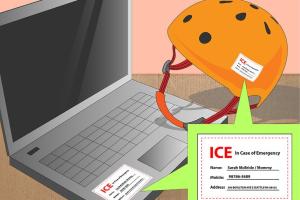How to Add ICE to Your Cell Phone: The Complete Guide

-
Quick Links:
- What is ICE?
- Importance of Adding ICE
- How to Add ICE to iOS Devices
- How to Add ICE to Android Devices
- Case Studies: Real-world Impact of ICE
- Expert Insights on Emergency Preparedness
- Common Misconceptions About ICE
- FAQs
What is ICE?
ICE stands for "In Case of Emergency." It is a system that allows individuals to store important emergency contact information on their mobile devices. The idea is simple: if you are incapacitated or unable to communicate, emergency responders can quickly access this critical information to contact your loved ones and obtain essential health details. The concept of ICE was first introduced in 2005 by Bob Brotchie, a paramedic in the UK, aiming to make emergency responses more efficient.
Importance of Adding ICE
Adding ICE to your cell phone is crucial for several reasons:
- Quick Access for First Responders: Emergency personnel can easily find who to contact and your medical history.
- Peace of Mind: Knowing that your loved ones can be reached in case of an emergency provides peace of mind.
- Customization: You can include specific medical conditions, allergies, and medications that can be vital during emergencies.
- Legitimacy: The ICE system is recognized globally, making it a consistent method in emergency situations.
How to Add ICE to iOS Devices
For iPhone users, adding ICE information is straightforward. Follow these steps:
Step 1: Open the Health App
Navigate to the Health app on your iPhone. This app is pre-installed and offers various health-related features.
Step 2: Tap on Your Profile
In the top right corner, tap on your profile picture or the icon to access your health profile.
Step 3: Medical ID
Scroll down and select "Medical ID." This section allows you to add critical health information, including emergency contacts.
Step 4: Add Emergency Contacts
Tap "Edit" in the top right corner, then scroll down to "Emergency Contacts." Here, you can add contacts who should be notified in case of an emergency.
Step 5: Include Additional Information
Fill in the necessary fields, including medical conditions, allergies, and medications. You can also enable the option to show your Medical ID when the phone is locked.
How to Add ICE to Android Devices
For Android users, the process varies slightly depending on the device, but the general steps are similar:
Step 1: Open the Contacts App
Launch the Contacts app on your Android device.
Step 2: Create a New Contact
Add a new contact named "ICE" or "In Case of Emergency." This makes it easy for responders to identify the contact.
Step 3: Add Relevant Information
Include phone numbers of family members, friends, or anyone you trust to be contacted in an emergency. You can also add notes about significant medical information.
Step 4: Use Lock Screen Shortcuts
Many Android devices allow you to display emergency contact information directly on the lock screen. Go to your device settings, find "Lock Screen" settings, and look for options to add emergency info.
Case Studies: Real-world Impact of ICE
Understanding the real-world implications of adding ICE information can be quite compelling. Here are a few case studies:
Case Study 1: The Timely Response
A 30-year-old man collapsed at a local gym. Paramedics found his phone and accessed the ICE contact, leading them to his partner who provided vital medical information. This swift action saved his life.
Case Study 2: The Car Accident
A woman was involved in a serious car accident. First responders were able to access her ICE information, which included her allergy to penicillin. This information was crucial when determining her treatment.
Expert Insights on Emergency Preparedness
Incorporating expert opinions can enhance the credibility of the ICE system. Here are insights from emergency response professionals:
Dr. Sarah Johnson, Emergency Medicine Specialist
"Having ICE information readily available can significantly reduce the time it takes to make critical medical decisions. It’s a small step that everyone should take."
Mike Thompson, Paramedic
"In emergencies, every second counts. Knowing who to contact and having access to medical history can be lifesaving. I advocate for everyone to add ICE to their phones."
Common Misconceptions About ICE
There are several misconceptions surrounding the ICE concept that could deter individuals from utilizing it:
- Misconception 1: Only elderly people need ICE.
- Misconception 2: It's not necessary if you have no medical conditions.
- Misconception 3: It's too complicated to set up.
FAQs
1. What information should I include in my ICE?
Include emergency contacts, medical conditions, allergies, and medications.
2. Can I add multiple ICE contacts?
Yes, it’s advisable to add multiple contacts for better accessibility.
3. Is ICE information secure?
The information is stored on your device and can be accessed by emergency personnel without unlocking the phone.
4. How will paramedics access my ICE information?
Paramedics can access your ICE information from the lock screen in most devices.
5. Can I update my ICE information easily?
Yes, you can update your ICE information anytime through your contacts or health app settings.
6. Do I need to have a smartphone to use ICE?
No, you can also write ICE information on a physical card and keep it in your wallet.
7. What if I change my emergency contacts frequently?
Regularly update your ICE information to reflect any changes in your contacts.
8. Should I include my medical history in ICE?
Yes, including critical medical history can help emergency responders provide better care.
9. What if I don’t have any close relatives?
Choose trusted friends or colleagues who can make decisions on your behalf if necessary.
10. Is there an app for managing ICE information?
Yes, there are several apps available that can help you manage your ICE details effectively.